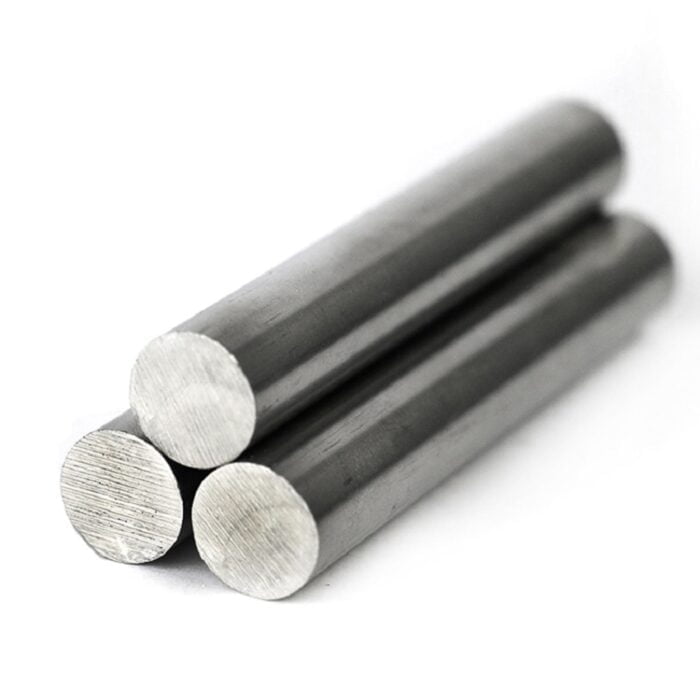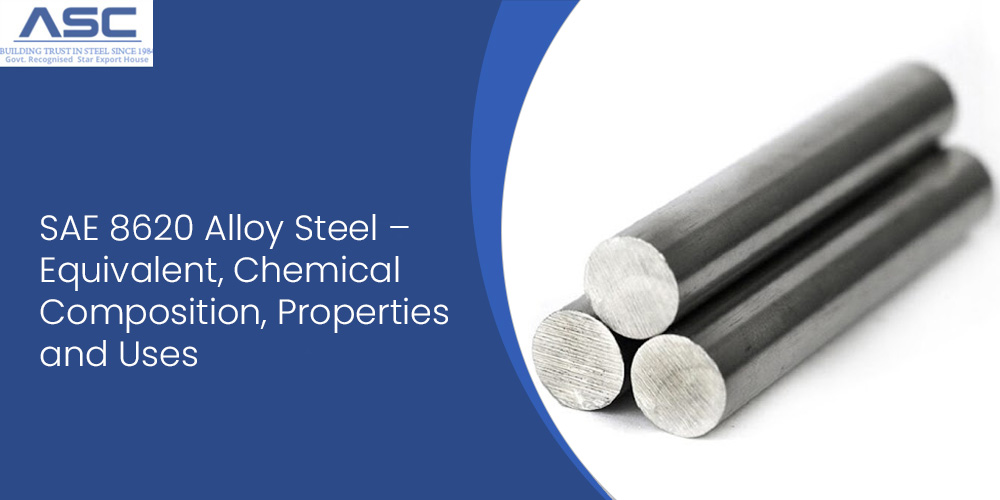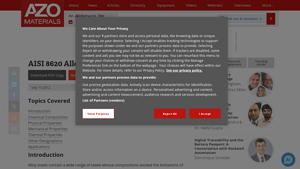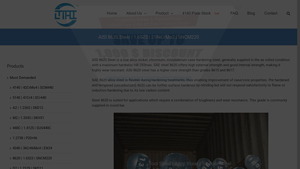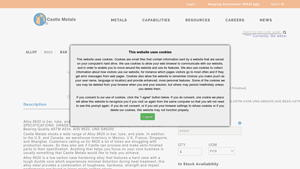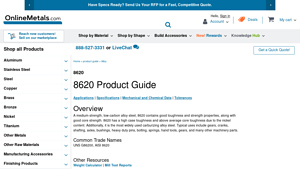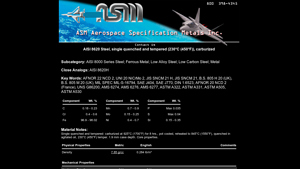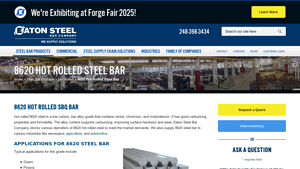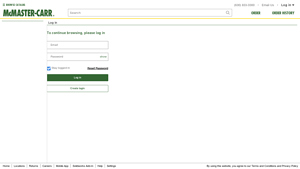8620 Alloy Steel Guide: Type, Cost, Top List…
Introduction: Navigating the Global Market for 8620 alloy steel
In today’s competitive landscape, sourcing high-quality 8620 alloy steel poses significant challenges for B2B buyers across Africa, South America, the Middle East, and Europe. This low alloy nickel, chromium, and molybdenum case hardening steel is renowned for its exceptional toughness and wear resistance, making it a preferred choice for applications ranging from gears and shafts to bushings and heavy-duty pins. However, navigating the complexities of material specifications, supplier reliability, and cost-effectiveness can be daunting.
This comprehensive guide aims to empower international B2B buyers with the insights needed to make informed purchasing decisions regarding 8620 alloy steel. We delve into various aspects, including the different types and grades available, their specific applications, and essential supplier vetting strategies. Additionally, we provide actionable insights on cost considerations and the latest market trends influencing the global steel industry.
By equipping buyers with the knowledge to assess material properties and supplier capabilities, this guide enhances their ability to secure reliable sources of 8620 alloy steel. Whether you are in Germany, Saudi Arabia, or any other key market, understanding these nuances will facilitate smoother procurement processes and ultimately contribute to the success of your projects.
Understanding 8620 alloy steel Types and Variations
| Type Name | Key Distinguishing Features | Primary B2B Applications | Brief Pros & Cons for Buyers |
|---|---|---|---|
| AISI 8620 | Low alloy, high wear resistance, good toughness, case hardenable | Gears, shafts, arbors, and bushings | Pros: Versatile applications, good machinability. Cons: Limited response to flame hardening. |
| AISI 8620H | Enhanced hardenability and toughness due to higher carbon content | Heavy-duty components, high-stress applications | Pros: Improved performance under stress. Cons: Higher cost compared to standard 8620. |
| SNCM220 | Japanese standard equivalent, optimized for toughness and fatigue | Automotive and aerospace components | Pros: Excellent fatigue resistance. Cons: Limited availability in some regions. |
| 21NiCrMo2 | European standard equivalent, higher nickel content for strength | High-performance gears and shafts | Pros: Superior toughness and wear resistance. Cons: May require specific heat treatment processes. |
| 805M20 | British standard variant, good machinability and wear resistance | General engineering applications | Pros: Cost-effective for general use. Cons: May not meet high-performance requirements. |
What Are the Characteristics of AISI 8620 Alloy Steel?
AISI 8620 is a low alloy steel known for its excellent wear resistance and toughness, making it suitable for various applications such as gears, shafts, and bushings. Its ability to be case-hardened allows it to maintain a tough core while providing a hard surface. When considering AISI 8620, buyers should evaluate the specific requirements of their applications, especially regarding hardness and toughness, and ensure that the material can be effectively machined post-treatment.
How Does AISI 8620H Differ from Standard 8620?
AISI 8620H offers enhanced hardenability and toughness due to its higher carbon content, making it ideal for heavy-duty components that experience significant stress. This variation is particularly beneficial in applications where strength and durability are critical. Buyers should consider the cost implications and ensure that the additional performance justifies the investment, especially for high-stress environments.
Why Choose SNCM220 for Automotive Applications?
SNCM220 is a Japanese equivalent of AISI 8620, optimized for toughness and fatigue resistance, making it a preferred choice in the automotive and aerospace industries. Its superior performance under cyclic loading conditions makes it suitable for critical components. Buyers should assess regional availability and ensure that their suppliers can provide this grade consistently to avoid production delays.
What Advantages Does 21NiCrMo2 Offer for High-Performance Parts?
21NiCrMo2, a European standard equivalent, features higher nickel content, which enhances its strength and toughness. This alloy is particularly effective for high-performance applications, such as in the manufacturing of gears and shafts that require superior wear resistance. Buyers should be aware of the specific heat treatment requirements to maximize the material’s performance and consider the expertise of their manufacturing partners.
When Is 805M20 the Right Choice for Engineering Applications?
805M20 is a British standard variant of 8620, known for its good machinability and wear resistance, making it a cost-effective option for general engineering applications. While it may not meet the rigorous demands of high-performance applications, it serves well in less critical environments. Buyers should evaluate their application’s performance requirements to determine if 805M20 offers the right balance of cost and performance.
Key Industrial Applications of 8620 alloy steel
| Industry/Sector | Specific Application of 8620 alloy steel | Value/Benefit for the Business | Key Sourcing Considerations for this Application |
|---|---|---|---|
| Automotive | Gears and Shafts | High wear resistance and core toughness for durability | Ensure compliance with international standards for quality. |
| Aerospace | Engine Components | Lightweight yet strong, enhancing fuel efficiency | Look for suppliers with certifications for aerospace-grade materials. |
| Oil and Gas | Drill Bits and Tooling | Excellent toughness and resistance to harsh environments | Source from vendors who offer heat-treated and carburized options. |
| Heavy Machinery | Bushings and Pins | Reduced downtime due to high wear resistance | Verify the availability of custom sizes and machining options. |
| Construction | Structural Components | Provides strength and durability for load-bearing applications | Consider local suppliers for reduced lead times and shipping costs. |
How is 8620 Alloy Steel Used in the Automotive Industry?
In the automotive sector, 8620 alloy steel is predominantly utilized for manufacturing gears and shafts. Its exceptional wear resistance and core toughness make it ideal for components that endure high stress and friction. International buyers must ensure that the steel meets specific automotive standards, such as ISO and SAE, to guarantee performance and safety. The ability to source pre-hardened or carburized variants enhances flexibility in manufacturing processes.
What Role Does 8620 Alloy Steel Play in Aerospace Applications?
The aerospace industry benefits from 8620 alloy steel due to its combination of strength and lightweight properties, making it suitable for critical engine components. The material’s ability to endure extreme conditions is vital for enhancing fuel efficiency and operational reliability. Buyers in this sector should prioritize suppliers that possess aerospace certifications and can provide detailed material traceability to meet stringent regulatory requirements.
Why is 8620 Alloy Steel Essential for Oil and Gas Drilling Tools?
In the oil and gas sector, 8620 alloy steel is commonly used for manufacturing drill bits and various tooling. The steel’s high toughness and wear resistance are crucial for withstanding the harsh conditions found in drilling environments. B2B buyers should seek suppliers who can offer heat-treated and carburized options to ensure that the products can withstand the rigorous demands of drilling operations, especially in offshore applications.
How is 8620 Alloy Steel Applied in Heavy Machinery?
Heavy machinery relies on 8620 alloy steel for components such as bushings and pins, where durability and resistance to wear are paramount. The material’s properties reduce downtime and maintenance costs, making it a cost-effective choice for manufacturers. Buyers should consider sourcing from vendors that can provide custom sizes and machining services to meet specific design requirements, ensuring a perfect fit for their machinery.
What Benefits Does 8620 Alloy Steel Provide in Construction?
In construction, 8620 alloy steel is utilized for structural components that require high strength and durability. Its ability to withstand heavy loads makes it suitable for beams and supports in various applications. For international buyers, sourcing from local suppliers can reduce lead times and shipping costs, while ensuring that the material meets regional building codes and standards.
3 Common User Pain Points for ‘8620 alloy steel’ & Their Solutions
Scenario 1: Sourcing Reliable Suppliers of 8620 Alloy Steel
The Problem: B2B buyers often struggle with finding reliable suppliers for 8620 alloy steel, especially when sourcing internationally. This is particularly challenging for companies in Africa, South America, and the Middle East, where local suppliers may have limited access to high-quality materials. Additionally, discrepancies in specifications and certifications can lead to costly delays and rejections during the procurement process.
The Solution: To mitigate this issue, buyers should develop a comprehensive supplier evaluation process that includes verifying certifications and quality standards specific to 8620 alloy steel, such as ASTM A29 and DIN 1654. Engaging with suppliers who provide full mill test reports (MTRs) can ensure that the material meets the required mechanical and chemical properties. It is also beneficial to establish long-term relationships with a few trusted suppliers, as this can enhance communication and reliability. Furthermore, utilizing international trade platforms and industry networks can help identify reputable suppliers who have a proven track record in delivering quality materials consistently.
Scenario 2: Ensuring Proper Heat Treatment for Optimal Performance
The Problem: Another common pain point for B2B buyers is ensuring that the 8620 alloy steel components undergo the correct heat treatment processes. Incorrect heat treatment can lead to issues such as reduced hardness, brittleness, or inadequate wear resistance, ultimately affecting product performance. Buyers often find it difficult to communicate these requirements effectively to manufacturers or fabricators who may lack expertise in handling alloy steels.
The Solution: To address this, buyers should provide detailed specifications regarding the heat treatment process when placing orders. This should include specific parameters such as austenitizing temperatures (840°C – 870°C), quenching methods (oil or water), and subsequent tempering temperatures (400°F to 1300°F). Collaborating closely with metallurgists or engineers who specialize in alloy steels can also help ensure that the correct processes are applied. Additionally, it is wise to conduct periodic audits or inspections of manufacturing processes to verify that heat treatment is performed as specified, reducing the risk of subpar material performance.
Scenario 3: Managing Cost-Effectiveness in Production
The Problem: Cost management is a critical concern for B2B buyers, especially when dealing with specialty materials like 8620 alloy steel. Fluctuating prices and the need for high-performance components can strain budgets, particularly for companies operating in price-sensitive markets. Buyers may find it challenging to balance the need for quality with cost-effectiveness, leading to potential compromises that could affect overall project viability.
The Solution: To achieve a balance between quality and cost, buyers should engage in thorough market research to understand current pricing trends and establish relationships with multiple suppliers to leverage competitive pricing. Additionally, exploring alternative forms of 8620, such as pre-hardened or surface-hardened variants, can offer cost savings while maintaining performance standards. Buyers should also evaluate the total cost of ownership, considering factors such as durability and maintenance costs, rather than just the upfront price. Implementing lean manufacturing practices can further optimize production efficiency, reducing waste and lowering costs associated with handling and processing 8620 alloy steel.
Strategic Material Selection Guide for 8620 alloy steel
What Are the Key Properties of 8620 Alloy Steel?
AISI 8620 alloy steel is characterized by its low alloy composition, which includes nickel, chromium, and molybdenum. This combination provides a balance of toughness and wear resistance, making it suitable for various applications. The material typically exhibits a tensile strength of approximately 530 MPa (77,000 psi) and a yield strength of around 385 MPa (56,000 psi). Its hardness can reach up to 255 HB, which is essential for components subjected to wear. Additionally, 8620 is known for its good core strength, which allows it to maintain structural integrity under stress.
What Are the Pros and Cons of Using 8620 Alloy Steel?
Pros:
– Durability: The alloy’s toughness and wear resistance make it ideal for heavy-duty applications, including gears and shafts.
– Machinability: 8620 can be readily machined after heat treatment, allowing for precise component fabrication.
– Carburizing Capability: It is highly suitable for carburizing, enhancing surface hardness while maintaining a tough core.
Cons:
– Cost: While generally cost-effective, the price may vary based on the alloying elements and processing methods.
– Manufacturing Complexity: The need for specific heat treatments and carburizing processes can complicate manufacturing, requiring skilled labor and specialized equipment.
– Limited Hardening Options: Due to its low carbon content, 8620 does not respond well to flame or induction hardening, which may limit its application in certain environments.
How Does 8620 Alloy Steel Impact Specific Applications?
8620 alloy steel is widely used in manufacturing components that require a combination of high surface wear resistance and good core strength. Typical applications include gears, camshafts, and various types of pins. Its ability to be carburized allows for controlled case depths, enhancing performance in high-stress environments. However, international buyers must consider the specific media compatibility based on the application. For instance, components exposed to corrosive environments may require additional surface treatments or coatings to prevent degradation.
What Should International B2B Buyers Consider When Sourcing 8620 Alloy Steel?
International B2B buyers, particularly from regions like Africa, South America, the Middle East, and Europe, should be aware of compliance with local and international standards. Common standards include ASTM, DIN, and JIS, which govern the quality and specifications of 8620 alloy steel. Buyers should also consider the availability of the material in various forms, such as round bars, plates, and tubes, to meet specific manufacturing needs. Additionally, understanding regional preferences for material properties and processing capabilities can enhance procurement strategies and ensure compatibility with local manufacturing practices.
| Material | Typical Use Case for 8620 alloy steel | Key Advantage | Key Disadvantage/Limitation | Relative Cost (Low/Med/High) |
|---|---|---|---|---|
| AISI 8620 Steel | Gears, camshafts, heavy-duty pins | Excellent toughness and wear resistance | Higher manufacturing complexity due to heat treatment | Medium |
| 8620 Round Bar | Shafts, bushings | Good machinability post-treatment | Limited hardening options | Medium |
| 8620 Plate | Structural components | High core strength | Cost may vary based on processing | Medium |
| 8620 Tubing | Hydraulic components | Versatile for various applications | Requires careful sourcing for specific sizes | Medium |
In-depth Look: Manufacturing Processes and Quality Assurance for 8620 alloy steel
What Are the Key Manufacturing Processes for 8620 Alloy Steel?
The manufacturing processes for 8620 alloy steel are critical in ensuring the material meets the rigorous standards required for various applications, particularly in industries such as automotive, aerospace, and machinery. The main stages include material preparation, forming, assembly, and finishing, each with specific techniques that contribute to the final product’s quality and performance.
How Is Material Prepared for 8620 Alloy Steel?
Material preparation begins with selecting high-quality raw materials that conform to the specified chemical composition of AISI 8620. This low-alloy steel typically contains nickel, chromium, and molybdenum, which enhance its mechanical properties. The initial step involves melting the raw materials in an electric arc furnace or induction furnace, followed by refining to remove impurities.
After refining, the steel is cast into various forms such as billets, bars, or plates, depending on the intended application. The material is then subjected to processes like hot rolling or cold drawing to achieve the desired dimensions and mechanical properties. During this stage, it’s crucial to monitor the temperature and cooling rates to ensure the material maintains its integrity and performance characteristics.
What Forming Techniques Are Used in 8620 Alloy Steel Production?
Forming techniques for 8620 alloy steel generally involve forging, machining, or both. Forging is typically done at high temperatures (approximately 2250ºF to 1700ºF) to enhance ductility and reduce the risk of cracking. The forged parts are then air-cooled to maintain their mechanical properties.
After forging, machining processes such as turning, milling, and grinding are employed to achieve precise dimensions and surface finishes. Machinability is a significant consideration, as the steel’s properties can change after heat treatment. B2B buyers should verify that suppliers utilize CNC machines and other advanced technology to ensure high precision and repeatability in manufacturing.
How Is Assembly Handled in the Manufacturing of 8620 Alloy Steel Components?
Assembly processes may vary depending on the final application of the 8620 steel components. In many cases, parts are assembled through welding or fastening. When welding, it is recommended to preheat the material to around 400°F to prevent cracking and ensure strong joints. However, welding is not advised after the steel has undergone hardening treatments.
For applications that require assembling multiple components, precise alignment and fitting are essential. Quality control during assembly is vital to ensure that all parts function correctly in their intended applications, such as in gears, shafts, or other machinery parts.
What Finishing Techniques Are Applied to 8620 Alloy Steel Products?
Finishing processes for 8620 alloy steel include heat treatment, surface hardening, and surface finishing. Heat treatment involves processes like annealing, normalizing, and tempering to enhance the steel’s toughness and hardness. For instance, tempering can be performed at temperatures ranging from 400°F to 1300°F to improve case toughness without significantly affecting hardness.
Surface hardening techniques such as carburizing or nitriding are often applied to enhance wear resistance, particularly for components subjected to high-stress conditions. Finally, surface finishing techniques, including grinding and polishing, are implemented to achieve the desired surface quality and dimensional accuracy.
What Are the Quality Assurance Measures for 8620 Alloy Steel?
Quality assurance (QA) is an integral part of the manufacturing process for 8620 alloy steel, ensuring that the final products meet international standards and customer specifications. The QA process typically adheres to ISO 9001 standards and may also comply with industry-specific regulations such as CE marking for European markets or API standards for oil and gas applications.
How Are International Standards Incorporated into Quality Control?
International standards play a crucial role in maintaining quality across the manufacturing process. ISO 9001 certification ensures that manufacturers implement a quality management system that emphasizes customer satisfaction and continual improvement. Compliance with these standards involves regular audits, documentation, and adherence to specific production processes.
In addition to ISO certifications, suppliers may also seek compliance with other industry-specific standards, such as those set by ASTM or EN. For B2B buyers, understanding these standards can provide insight into a supplier’s commitment to quality and reliability.
What Are the Key Quality Control Checkpoints in Manufacturing 8620 Alloy Steel?
Quality control checkpoints are strategically placed throughout the manufacturing process to ensure that the final product meets established specifications. Key checkpoints include:
- Incoming Quality Control (IQC): This stage involves inspecting raw materials upon receipt to ensure they meet the required chemical and physical properties.
- In-Process Quality Control (IPQC): During manufacturing, various tests are conducted at different stages to monitor process parameters and material properties. This may include dimensional checks and non-destructive testing (NDT) methods.
- Final Quality Control (FQC): Once the products are completed, they undergo final inspections, including mechanical testing (tensile, hardness) and surface integrity checks, to confirm they meet specifications before shipment.
How Can B2B Buyers Verify Supplier Quality Control Practices?
For international B2B buyers, verifying a supplier’s quality control practices is crucial. This can be achieved through several methods:
- Supplier Audits: Conducting on-site audits can provide firsthand insight into a supplier’s manufacturing processes and quality management systems.
- Quality Reports and Certifications: Requesting documentation, such as ISO certifications, quality assurance reports, and inspection records, helps buyers gauge a supplier’s commitment to quality.
- Third-Party Inspections: Engaging independent third-party inspection services can validate compliance with required standards and specifications, offering additional assurance of product quality.
What QC and Certification Nuances Should International Buyers Consider?
When sourcing 8620 alloy steel, international buyers should be aware of certification nuances that may affect their procurement decisions. For example, different regions may have specific requirements for compliance, such as CE marking in Europe, which indicates conformity with health, safety, and environmental protection standards.
Additionally, understanding the local regulations in target markets—such as those in Africa, South America, the Middle East, and Europe—can inform buyers about potential challenges in sourcing materials. A thorough understanding of these nuances will help buyers make informed decisions and establish reliable supply chains.
By focusing on these manufacturing processes and quality assurance measures, B2B buyers can ensure they source high-quality 8620 alloy steel suitable for their specific applications, thereby enhancing their operational efficiency and product performance.
Practical Sourcing Guide: A Step-by-Step Checklist for ‘8620 alloy steel’
To assist B2B buyers in procuring 8620 alloy steel effectively, this practical sourcing guide outlines essential steps to ensure a successful acquisition process. By following this checklist, buyers can navigate the complexities of sourcing and secure high-quality materials that meet their specific needs.
Step 1: Define Your Technical Specifications
Clearly outline your requirements for 8620 alloy steel, including dimensions, mechanical properties, and surface finish. This step is crucial as it helps suppliers understand your needs and provides a basis for comparison among different offerings. Consider factors like hardness, tensile strength, and intended application to ensure the material will perform as expected.
- Key Specifications to Include:
- Desired shape (e.g., round bar, plate, square bar)
- Specific grades or standards (e.g., ASTM A29, DIN 1654)
- Required surface finish (e.g., black, machined)
Step 2: Research Potential Suppliers
Conduct thorough research to identify suppliers who specialize in 8620 alloy steel. Look for companies with a strong reputation in the industry and a history of supplying high-quality materials. This foundational step can prevent future issues related to product quality and delivery reliability.
- What to Look For:
- Supplier reviews and testimonials
- Industry certifications (e.g., ISO 9001)
- Geographic proximity for easier logistics
Step 3: Evaluate Supplier Certifications
Before making a decision, verify that your potential suppliers hold relevant certifications. Certifications indicate that the supplier adheres to industry standards and practices, ensuring the quality and reliability of the materials provided.
- Important Certifications:
- ISO certifications
- ASTM compliance
- Local industry standards relevant to your region
Step 4: Request Samples and Test Materials
Before committing to a large order, request samples of 8620 alloy steel. Testing samples for mechanical properties and compatibility with your manufacturing processes can reveal any potential issues early in the sourcing process.
- Testing Considerations:
- Conduct hardness tests and tensile strength evaluations.
- Ensure samples meet your specified technical requirements.
Step 5: Negotiate Pricing and Terms
Once you’ve selected a supplier, engage in negotiations to establish fair pricing and favorable terms. Understanding the market price for 8620 alloy steel will help you negotiate effectively and ensure that you are getting a competitive deal.
- Key Negotiation Points:
- Bulk purchase discounts
- Payment terms (e.g., upfront, net 30)
- Delivery timelines and logistics
Step 6: Confirm Logistics and Delivery Arrangements
Finalize logistics by confirming delivery timelines and transportation methods. This is particularly important for international buyers, as shipping can significantly impact project timelines.
- Logistics Considerations:
- Shipping methods (air, sea, land)
- Customs clearance processes for international shipments
- Packaging requirements to prevent damage during transit
Step 7: Monitor and Evaluate Supplier Performance
After placing your order, continuously monitor the supplier’s performance. Evaluate the quality of the 8620 alloy steel received and the supplier’s adherence to delivery schedules.
- Performance Metrics to Track:
- Quality of materials upon receipt
- Timeliness of delivery
- Responsiveness to inquiries and issues
By following these steps, B2B buyers can enhance their sourcing process for 8620 alloy steel, ensuring they obtain high-quality materials that meet their operational needs.
Comprehensive Cost and Pricing Analysis for 8620 alloy steel Sourcing
When sourcing 8620 alloy steel, international B2B buyers must navigate a multifaceted cost structure that encompasses various components. Understanding these factors can lead to more informed purchasing decisions and ultimately better financial outcomes.
What Are the Key Cost Components in Sourcing 8620 Alloy Steel?
-
Material Costs: The primary expense in sourcing 8620 alloy steel arises from the raw materials themselves. Prices fluctuate based on global demand for nickel, chromium, and molybdenum, which are integral to this low-alloy steel. Buyers should keep abreast of market trends to anticipate price changes.
-
Labor Costs: Labor expenses are incurred during the manufacturing processes, including forging, heat treatment, and machining. Regions with higher labor costs will naturally influence the overall price. For example, sourcing from Europe may involve higher labor costs compared to suppliers in regions like South America or Africa.
-
Manufacturing Overhead: This includes costs associated with operating machinery, facility maintenance, and utilities. Suppliers with advanced production capabilities may charge a premium for their services, reflecting their operational efficiencies.
-
Tooling Costs: Specialized tooling for producing 8620 alloy steel components can be significant, especially for custom specifications. The initial investment in tooling can be amortized over large production runs, making it crucial to consider the volume of steel required.
-
Quality Control (QC): Ensuring that 8620 alloy steel meets specific standards requires rigorous quality control measures. The costs associated with testing and certification can vary widely depending on the supplier’s quality assurance protocols.
-
Logistics Costs: Transportation, warehousing, and handling fees are essential components of the overall cost structure. For international buyers, understanding Incoterms can significantly affect logistics costs and responsibilities.
-
Margin: Suppliers will include a profit margin in their pricing, which can vary based on their market position, competition, and relationship with buyers. Negotiating favorable terms can help in reducing the overall procurement costs.
How Do Various Factors Influence the Pricing of 8620 Alloy Steel?
-
Volume and Minimum Order Quantity (MOQ): Bulk orders typically yield better pricing due to economies of scale. Buyers should negotiate MOQs to optimize their costs.
-
Specifications and Customization: Custom requirements, such as specific dimensions or surface finishes, can increase costs. Buyers should balance the need for customization with the potential for added expenses.
-
Material Quality and Certifications: Higher quality materials and certifications (e.g., ISO, ASTM) command premium prices. Buyers should assess whether the added costs align with their performance needs.
-
Supplier Factors: The reputation and reliability of suppliers can significantly impact pricing. Established suppliers may charge more but offer better quality assurance and service.
-
Incoterms: These terms define the responsibilities of buyers and sellers in international transactions. Understanding them can help buyers manage logistics costs and risks effectively.
What Tips Can Help B2B Buyers Negotiate Better Prices for 8620 Alloy Steel?
-
Negotiate Volume Discounts: Leverage larger orders to negotiate better pricing, which can lead to significant savings in the long term.
-
Assess Total Cost of Ownership (TCO): Consider not just the purchase price but also the long-term costs associated with quality, durability, and maintenance of the steel in application.
-
Understand Pricing Nuances: For buyers from Africa, South America, the Middle East, and Europe, local economic conditions, tariffs, and trade agreements can influence pricing. Engage local experts to navigate these complexities.
-
Establish Long-Term Relationships: Building strong relationships with suppliers can lead to better terms, priority service, and potential cost reductions over time.
Disclaimer for Indicative Prices
Pricing for 8620 alloy steel can vary widely based on the factors outlined above. Buyers are encouraged to obtain detailed quotes from multiple suppliers and consider the total cost implications when making purchasing decisions. Always consult with suppliers for the most accurate and up-to-date pricing information tailored to specific needs.
Alternatives Analysis: Comparing 8620 alloy steel With Other Solutions
Introduction to Alternatives in Alloy Steel Solutions
When selecting materials for industrial applications, it’s crucial for B2B buyers to consider various options that can fulfill specific requirements. While AISI 8620 alloy steel is renowned for its toughness and wear resistance, it’s essential to evaluate alternative materials and methods that may provide similar or enhanced performance based on unique operational demands. This analysis will compare 8620 alloy steel against two notable alternatives: 4140 alloy steel and case-hardened carbon steel.
| Comparison Aspect | 8620 Alloy Steel | 4140 Alloy Steel | Case-Hardened Carbon Steel |
|---|---|---|---|
| Performance | High toughness and wear resistance | Excellent strength and toughness | Good wear resistance with surface hardening |
| Cost | Moderate | Higher than 8620 due to alloying elements | Lower, depending on carbon content |
| Ease of Implementation | Requires specific heat treatment | Easier to machine but requires heat treatment | Simple machining but needs hardening process |
| Maintenance | Moderate, with attention to corrosion | Low, but can be susceptible to wear | Low if properly treated |
| Best Use Case | Gears, shafts, and components needing toughness | Heavy-duty applications like axles and crankshafts | General machinery parts requiring surface hardness |
Detailed Breakdown of Alternatives
What Are the Advantages and Disadvantages of 4140 Alloy Steel?
4140 alloy steel is a versatile medium-carbon steel that includes chromium and molybdenum. Its enhanced alloying elements provide superior strength and toughness, making it ideal for applications where high fatigue resistance is necessary. However, the cost of 4140 can be higher than 8620 due to the additional alloying elements. While it offers excellent machinability, it requires proper heat treatment to realize its full potential, which can add complexity to production processes.
How Does Case-Hardened Carbon Steel Compare?
Case-hardened carbon steel is known for its ability to achieve a hard surface while maintaining a ductile core. This material is often more economical than alloy steels, making it an attractive option for budget-conscious projects. However, the performance may not match that of 8620 or 4140 in terms of overall toughness and wear resistance. While case-hardening processes can enhance surface properties, they require additional processing steps, which can complicate implementation.
Conclusion: How to Choose the Right Material for Your Needs
Selecting the right material for your industrial applications is pivotal to achieving optimal performance and cost-effectiveness. AISI 8620 alloy steel is an excellent choice for applications demanding high toughness and wear resistance. However, alternatives like 4140 alloy steel and case-hardened carbon steel may offer distinct advantages depending on specific requirements, such as budget constraints or the need for enhanced strength. B2B buyers should assess their operational needs, including performance expectations, cost considerations, and ease of implementation, to make an informed decision that aligns with their project objectives.
Essential Technical Properties and Trade Terminology for 8620 alloy steel
What Are the Key Technical Properties of 8620 Alloy Steel?
1. Material Grade and Composition
8620 alloy steel is categorized under low-alloy, nickel-chromium-molybdenum steels, primarily recognized for its case hardening properties. The chemical composition includes carbon (0.18-0.23%), manganese (0.7-0.9%), nickel (0.4-0.7%), chromium (0.4-0.6%), and molybdenum (0.15-0.25%). Understanding the material grade is crucial for B2B buyers as it determines the steel’s suitability for specific applications, particularly where toughness and wear resistance are essential, such as in gears and shafts.
2. Mechanical Properties
The mechanical properties of 8620 steel include a tensile strength of approximately 530 MPa (77,000 psi) and a yield strength of about 385 MPa (56,000 psi). These properties indicate the steel’s ability to withstand stress without deforming, which is vital for components subjected to dynamic loads. Buyers must assess these metrics to ensure that the material can handle the operational demands of their specific applications.
3. Hardness Ratings
8620 alloy steel typically has a Brinell hardness rating of up to 255 HB, which can vary based on the heat treatment process. Hardness is a critical factor for industries requiring high wear resistance, particularly in automotive and manufacturing sectors. Buyers should consider hardness specifications when selecting materials for parts that will encounter abrasive conditions.
4. Machinability and Fabrication
With a machinability rating of approximately 65% (based on AISI 1212), 8620 is relatively easy to machine, especially after heat treatment. This property is significant for manufacturers who require precision in component fabrication. Understanding machinability helps buyers estimate production costs and timelines effectively.
5. Heat Treatment Process
8620 steel can undergo various heat treatment processes such as annealing, tempering, and carburizing to enhance its properties. For instance, carburizing improves surface hardness while maintaining core toughness. Buyers need to be aware of these processes to ensure that the steel meets the specific performance requirements of their applications.
What Are Common Trade Terms Related to 8620 Alloy Steel?
1. OEM (Original Equipment Manufacturer)
OEM refers to companies that produce parts or equipment that may be marketed by another manufacturer. In the context of 8620 alloy steel, buyers often deal with OEMs who require specific grades and properties for their products. Understanding OEM relationships helps buyers ensure they are sourcing from reputable manufacturers that meet industry standards.
2. MOQ (Minimum Order Quantity)
MOQ is the smallest quantity of a product that a supplier is willing to sell. For 8620 alloy steel, knowing the MOQ can impact inventory management and procurement strategies. Buyers must evaluate their needs against supplier MOQs to avoid overstocking or shortages.
3. RFQ (Request for Quotation)
An RFQ is a document that solicits price bids from suppliers for specific products or services. When dealing with 8620 alloy steel, submitting an RFQ helps buyers obtain competitive pricing and terms tailored to their project specifications. This process is essential for budget management and cost control.
4. Incoterms (International Commercial Terms)
Incoterms are standardized trade terms that define the responsibilities of buyers and sellers in international transactions. Familiarity with Incoterms is crucial for B2B buyers of 8620 alloy steel, as they determine who bears the costs and risks during shipping. This knowledge can facilitate smoother negotiations and logistics planning.
5. Tolerance
Tolerance refers to the permissible limit of variation in a physical dimension. In the context of 8620 alloy steel, understanding tolerances is vital for ensuring that components fit and function correctly in their intended applications. Buyers must specify tolerances to guarantee compatibility with existing systems and components.
These technical properties and trade terms are foundational for international B2B buyers navigating the complexities of sourcing 8620 alloy steel. Understanding these aspects can lead to better decision-making and improved supplier relationships.
Navigating Market Dynamics and Sourcing Trends in the 8620 alloy steel Sector
What Are the Current Market Dynamics and Key Trends Influencing the 8620 Alloy Steel Sector?
The global market for 8620 alloy steel is shaped by several key drivers, including the increasing demand for high-performance materials in various industries such as automotive, aerospace, and manufacturing. The versatility of 8620 steel, known for its toughness and wear resistance, positions it favorably in applications like gears, shafts, and heavy-duty components. As industries evolve, there is a growing emphasis on the customization of steel products, prompting suppliers to offer tailored solutions that meet specific engineering requirements.
Emerging technologies in manufacturing, such as advanced machining processes and heat treatment innovations, are also transforming the sourcing landscape. B2B buyers are increasingly leveraging digital platforms for procurement, seeking real-time data and analytics to optimize their supply chains. Moreover, geographic regions such as Africa, South America, the Middle East, and Europe are witnessing a rise in local manufacturing capabilities, reducing dependence on imports and enhancing the resilience of supply chains. This shift presents opportunities for regional suppliers to penetrate international markets by offering competitive pricing and shorter lead times.
How Can B2B Buyers Ensure Sustainability and Ethical Sourcing for 8620 Alloy Steel?
Sustainability is becoming a crucial consideration in the procurement of materials like 8620 alloy steel. The environmental impact of steel production, including carbon emissions and resource depletion, has led to a demand for greener practices within the industry. B2B buyers are increasingly prioritizing suppliers who implement sustainable manufacturing processes and offer certifications that demonstrate their commitment to environmental stewardship.
Ethical sourcing is another important aspect for international buyers. Establishing transparent supply chains that adhere to ethical labor practices can enhance brand reputation and build trust with stakeholders. Buyers should look for suppliers that provide ‘green’ certifications, such as ISO 14001 for environmental management systems or certificates for recycled content in their materials. Such certifications not only support sustainability goals but also align with the growing consumer demand for responsible sourcing practices.
What Is the Historical Context of 8620 Alloy Steel in B2B Markets?
The development of 8620 alloy steel can be traced back to the evolution of alloy steels in the early 20th century, driven by the need for materials that could withstand higher stresses and provide better wear resistance. Initially used in the automotive industry, its application has expanded significantly due to its favorable mechanical properties and adaptability to various heat treatment processes.
Over the decades, 8620 steel has become a staple in industries requiring durable components, thanks to advancements in metallurgy and manufacturing techniques. The alloy’s composition, which includes nickel, chromium, and molybdenum, has been optimized to enhance its case hardening capabilities, making it a preferred choice for critical applications. As global demand for high-quality materials continues to rise, 8620 alloy steel remains integral to various sectors, symbolizing the ongoing innovation and adaptation within the steel industry.
Frequently Asked Questions (FAQs) for B2B Buyers of 8620 alloy steel
-
How do I determine the right specifications for 8620 alloy steel for my application?
To identify the correct specifications for 8620 alloy steel, begin by assessing the specific requirements of your application. Consider factors such as mechanical properties, hardness levels, and the need for case hardening. Review the chemical composition standards, such as ASTM A29, to ensure compatibility with your design. Collaborate with your engineering team to evaluate load-bearing requirements and environmental conditions. Once you have a clear understanding, consult with suppliers to confirm that the grade meets your technical needs. -
What is the best heat treatment process for enhancing the properties of 8620 alloy steel?
The optimal heat treatment for 8620 alloy steel typically involves austenitizing at 840°C to 870°C, followed by oil or water quenching. This process improves hardness and strength. For applications requiring additional toughness, tempering at temperatures between 400°F and 1300°F is recommended, as it enhances case toughness while minimally affecting hardness. Always consult with your supplier to ensure that the heat treatment aligns with your specific requirements for performance and durability. -
What are the common applications of 8620 alloy steel in various industries?
8620 alloy steel is widely used in manufacturing components that require a combination of toughness and wear resistance. Common applications include gears, shafts, bushings, and heavy-duty pins. Its high surface wear resistance makes it suitable for automotive parts such as camshafts and differential pinions. Industries like aerospace, automotive, and machinery heavily rely on 8620 for parts that demand both high core strength and the ability to undergo carburizing for enhanced surface hardness. -
What are the key factors to consider when vetting suppliers of 8620 alloy steel?
When vetting suppliers, focus on their industry reputation, quality certifications (such as ISO 9001), and experience in supplying 8620 alloy steel. Request references from previous clients and review their production capabilities, including the availability of heat treatment and customization options. Additionally, consider their logistics and delivery reliability, as timely supply is crucial for maintaining your production schedules. Always verify their compliance with international standards relevant to your region. -
What is the minimum order quantity (MOQ) for 8620 alloy steel, and does it vary by supplier?
The minimum order quantity for 8620 alloy steel can vary significantly between suppliers, typically ranging from 500 kg to several tons. Some suppliers may offer flexibility for smaller orders, especially for custom specifications or new clients. It’s advisable to discuss your specific needs with potential suppliers to understand their MOQ policies and negotiate terms that suit your procurement strategy. Consider pooling orders with other buyers to meet MOQs if necessary. -
What payment terms should I expect when sourcing 8620 alloy steel internationally?
Payment terms for international sourcing of 8620 alloy steel often include options such as advance payment, letters of credit, or payment upon delivery, depending on the supplier’s policy and your negotiation. Terms such as 30% upfront with the balance upon delivery are common. Be sure to clarify payment methods, currency, and any associated banking fees beforehand. Establishing clear payment terms can help mitigate risks associated with international transactions. -
How can I ensure quality assurance (QA) for my 8620 alloy steel orders?
To ensure quality assurance, request detailed mill test reports (MTRs) from your supplier that outline the chemical and mechanical properties of the material. Implement a robust inspection process upon receipt, including dimensional checks and hardness testing. Consider third-party inspection services if necessary, especially for large orders or critical applications. Establishing a clear quality agreement with the supplier can also help ensure that the materials meet your specifications consistently. -
What logistics considerations should I keep in mind when importing 8620 alloy steel?
When importing 8620 alloy steel, consider logistics factors such as shipping methods, customs clearance, and delivery timelines. Evaluate the supplier’s ability to provide reliable shipping options that meet your deadlines. Be aware of customs regulations in your country, including tariffs and duties that may apply. Working with a logistics partner experienced in international trade can streamline the process and help mitigate potential delays or compliance issues.
Important Disclaimer & Terms of Use
⚠️ Important Disclaimer
The information provided in this guide, including content regarding manufacturers, technical specifications, and market analysis, is for informational and educational purposes only. It does not constitute professional procurement advice, financial advice, or legal advice.
While we have made every effort to ensure the accuracy and timeliness of the information, we are not responsible for any errors, omissions, or outdated information. Market conditions, company details, and technical standards are subject to change.
B2B buyers must conduct their own independent and thorough due diligence before making any purchasing decisions. This includes contacting suppliers directly, verifying certifications, requesting samples, and seeking professional consultation. The risk of relying on any information in this guide is borne solely by the reader.
Top 7 8620 Alloy Steel Manufacturers & Suppliers List
1. AISI 8620 – Carburizing Alloy Steel
Domain: azom.com
Registered: 1999 (26 years)
Introduction: AISI 8620 Alloy Steel (UNS G86200) is a common carburizing alloy steel known for its flexibility during hardening treatments, which improves case/core properties.
**Chemical Composition:**
– Iron (Fe): 96.895-98.02%
– Manganese (Mn): 0.700-0.900%
– Nickel (Ni): 0.400-0.700%
– Chromium (Cr): 0.400-0.600%
– Carbon (C): 0.180-0.230%
– Silicon (Si): 0.150-0.350%
– Molybdenum (Mo): 0.15…
2. ASTM Steel – AISI 8620 Round Bar
Domain: astmsteel.com
Registered: 2015 (10 years)
Introduction: This company, ASTM Steel – AISI 8620 Round Bar, is a notable entity in the market. For specific product details, it is recommended to visit their website directly.
3. Castle Metals – 8620 Round Steel Bar 1.25 IN
Domain: castlemetals.com
Registered: 1996 (29 years)
Introduction: {“item_number”:”2104″,”grade”:”8620″,”shape”:”Round”,”size”:”1.25 IN”,”length_range”:”120.0000-156.0000 IN”,”specifications”:[“AISI.8620″,”ASTM.A304″,”ASTM.A29″,”ASTM.A108″,”UNS.G86200″,”SAE.8620″,”ASTM.A322″],”lbs_per_ft”:”4.17″,”availability”:”In Stock”,”tolerance”:{“length_tolerance”:”TOL + 0.125 – 0.000 INCH, TOL + 0.000 – 0.125 INCH, TOL +/- 0.063 INCH”},”description”:”Alloy 8620 in bar, tube…
4. Online Metals – Alloy Steel 8620
Domain: onlinemetals.com
Registered: 1997 (28 years)
Introduction: {‘name’: ‘Alloy Steel 8620’, ‘description’: ‘A medium-strength, low-carbon alloy steel with good toughness and strength properties, along with good core strength. It has high case toughness and above-average core toughness due to nickel content. Widely used for carburizing applications.’, ‘applications’: [‘Gears’, ‘Cranks’, ‘Shafting’, ‘Axles’, ‘Bushings’, ‘Heavy Duty Pins’, ‘Bolting’, ‘Springs’, …
5. AISI 8620 Steel – Low Alloy Ferrous Metal
Domain: asm.matweb.com
Registered: 1997 (28 years)
Introduction: {“Material Name”: “AISI 8620 Steel”, “Subcategory”: “AISI 8000 Series Steel; Ferrous Metal; Low Alloy Steel; Low Carbon Steel”, “Close Analogs”: “AISI 8620H”, “Keywords”: [“AFNOR 22 NCD 2”, “UNI 20 NiCrMo 2”, “JIS SNCM 21 H”, “JIS SNCM 21”, “B.S. 805 H 20 (UK)”, “B.S. 805 M 20 (UK)”, “MIL SPEC MIL-S-16794”, “SAE J404”, “SAE J770”, “DIN 1.6523”, “AFNOR 20 NCD 2 (France)”, “UNS G86200”, “AMS 6274”, …
6. Eaton Steel Bar Company – 8620 Hot Rolled Steel Bar
Domain: eatonsteel.com
Registered: 1996 (29 years)
Introduction: {‘product_name’: ‘8620 Hot Rolled Steel Bar’, ‘supplier’: ‘Eaton Steel Bar Company’, ‘material_type’: ‘Low carbon, low alloy steel’, ‘alloy_elements’: [‘Nickel’, ‘Chromium’, ‘Molybdenum’], ‘properties’: [‘Good carburizing properties’, ‘Good formability’, ‘Improved surface hardness and wear’], ‘applications’: [‘Gears’, ‘Pinions’, ‘Shafts’, ‘Bushings’, ‘Bolts’, ‘Camshafts’, ‘Chains’, ‘Drive Wheels’,…
7. McMaster – Grade 8620 Steel
Domain: mcmaster.com
Registered: 1994 (31 years)
Introduction: This company, McMaster – Grade 8620 Steel, is a notable entity in the market. For specific product details, it is recommended to visit their website directly.
Strategic Sourcing Conclusion and Outlook for 8620 alloy steel
In the competitive landscape of alloy steel procurement, understanding the nuances of AISI 8620 is crucial for international B2B buyers. This versatile low-alloy steel, known for its impressive toughness, wear resistance, and adaptability during heat treatment, is ideal for a range of applications from gears to bushings. The strategic sourcing of 8620 alloy steel not only enhances product performance but also optimizes supply chain efficiency and cost-effectiveness.
Buyers in regions such as Africa, South America, the Middle East, and Europe must prioritize suppliers who can provide high-quality materials that meet specific industrial standards and certifications. By aligning with reputable manufacturers, companies can ensure access to consistent, reliable products that support their operational goals.
Looking ahead, the demand for robust and resilient materials like 8620 alloy steel is set to rise, driven by advancements in manufacturing and engineering. International buyers are encouraged to actively seek partnerships with trusted suppliers and explore innovative solutions that leverage the unique properties of 8620. By doing so, they can position themselves for success in a rapidly evolving market.
